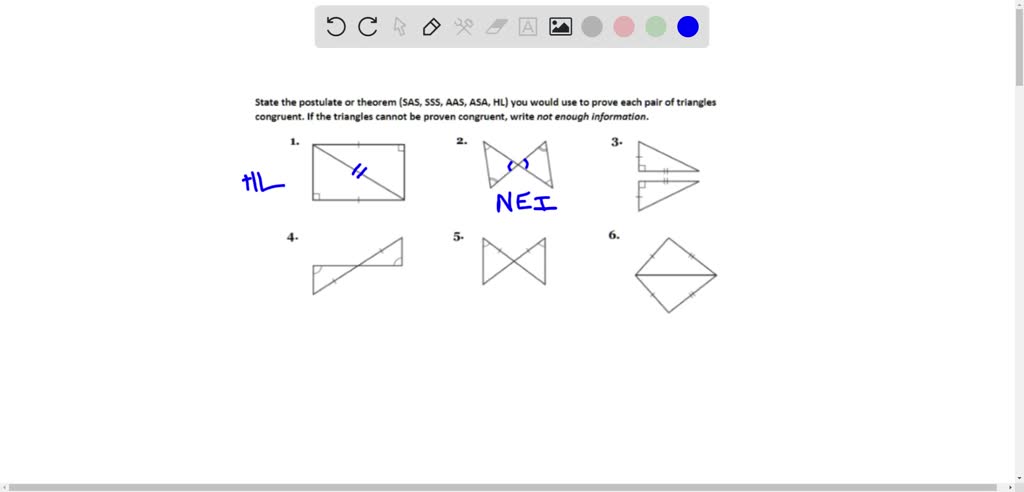Congruence of triangles is a fundamental concept in geometry, where two triangles are congruent if they have exactly the same size and shape. Several methods exist to prove the congruence of triangles, and one of the most commonly used methods is the Side-Angle-Side (SAS) Congruence Theorem. This article explores the SAS Congruence Theorem in detail and provides insights into its application in proving the congruence of triangle pairs.
Understanding Triangle Congruence
Triangle congruence means that two triangles are identical in terms of their side lengths and angles. When two triangles are congruent, all corresponding sides are equal in length, and all corresponding angles are equal in measure. There are several criteria used to determine triangle congruence:
- Side-Side-Side (SSS) Congruence Theorem: If three sides of one triangle are equal to three sides of another triangle, the triangles are congruent.
- Angle-Side-Angle (ASA) Congruence Theorem: If two angles and the included side of one triangle are equal to two angles and the included side of another triangle, the triangles are congruent.
- Side-Angle-Side (SAS) Congruence Theorem: If two sides and the included angle of one triangle are equal to two sides and the included angle of another triangle, the triangles are congruent.
- Angle-Angle-Side (AAS) Congruence Theorem: If two angles and a non-included side of one triangle are equal to two angles and the corresponding non-included side of another triangle, the triangles are congruent.
- Right Angle-Hypotenuse-Side (RHS) Congruence Theorem: For right-angled triangles, if the hypotenuse and one side of one triangle are equal to the hypotenuse and one side of another triangle, the triangles are congruent.
Among these criteria, the SAS Congruence Theorem is particularly useful and often applied in various geometric proofs.
What is the SAS Congruence Theorem?
The Side-Angle-Side (SAS) Congruence Theorem states that if two sides and the included angle of one triangle are congruent to two sides and the included angle of another triangle, then the two triangles are congruent. This theorem is named SAS because it involves two sides and the angle between them.
Mathematical Representation: Given two triangles, ΔABC\Delta ABCΔABC and ΔDEF\Delta DEFΔDEF, if:
- AB=DEAB = DEAB=DE
- AC=DFAC = DFAC=DF
- ∠BAC=∠EDF\angle BAC = \angle EDF∠BAC=∠EDF
Then, ΔABC≅ΔDEF\Delta ABC \cong \Delta DEFΔABC≅ΔDEF.
Applying the SAS Congruence Theorem
To apply the SAS Congruence Theorem, follow these steps:
- Identify the Two Triangles: Determine the two triangles you want to prove congruent.
- Compare Two Sides: Check if two sides of one triangle are equal in length to two sides of the other triangle.
- Check the Included Angle: Verify that the angle between the two sides in one triangle is equal to the angle between the corresponding two sides in the other triangle.
- Conclude Congruence: If the above conditions are met, conclude that the triangles are congruent by the SAS Congruence Theorem.
Example Problems
Example 1
Consider two triangles ΔABC\Delta ABCΔABC and ΔDEF\Delta DEFΔDEF with the following measurements:
- AB=5AB = 5AB=5 cm, AC=7AC = 7AC=7 cm, ∠BAC=60∘\angle BAC = 60^\circ∠BAC=60∘
- DE=5DE = 5DE=5 cm, DF=7DF = 7DF=7 cm, ∠EDF=60∘\angle EDF = 60^\circ∠EDF=60∘
Since two sides and the included angle of ΔABC\Delta ABCΔABC are congruent to two sides and the included angle of ΔDEF\Delta DEFΔDEF, we can conclude that ΔABC≅ΔDEF\Delta ABC \cong \Delta DEFΔABC≅ΔDEF by the SAS Congruence Theorem.
Example 2
Given triangles ΔPQR\Delta PQRΔPQR and ΔSTU\Delta STUΔSTU with:
- PQ=8PQ = 8PQ=8 cm, PR=6PR = 6PR=6 cm, ∠QPR=45∘\angle QPR = 45^\circ∠QPR=45∘
- ST=8ST = 8ST=8 cm, SU=6SU = 6SU=6 cm, ∠TSU=45∘\angle TSU = 45^\circ∠TSU=45∘
Here, the pairs of sides and the included angles are congruent. Therefore, ΔPQR≅ΔSTU\Delta PQR \cong \Delta STUΔPQR≅ΔSTU by SAS.
Importance and Applications of SAS Congruence Theorem
The SAS Congruence Theorem is crucial in various fields such as architecture, engineering, and computer graphics. Here are some applications:
- Architectural Design: Ensuring structural components are congruent for stability and aesthetic purposes.
- Engineering: In mechanical and civil engineering, congruent triangles are used in the design of trusses and bridges.
- Computer Graphics: Congruence theorems help in rendering objects and ensuring symmetry in digital designs.
- Mathematical Proofs: SAS is extensively used in proving other geometric properties and theorems.
Challenges and Common Mistakes
When applying the SAS Congruence Theorem, it is crucial to ensure that the angle is indeed the included angle between the two sides. A common mistake is to consider a non-included angle, which can lead to incorrect conclusions about triangle congruence.
FAQ
What does the SAS Congruence Theorem state?
The SAS Congruence Theorem states that if two sides and the included angle of one triangle are congruent to two sides and the included angle of another triangle, then the triangles are congruent.
Can the SAS Congruence Theorem be used with non-included angles?
No, the SAS Congruence Theorem specifically requires that the angle be the included angle between the two sides being compared. Using a non-included angle does not satisfy the theorem’s conditions.
Why is the included angle important in the SAS Congruence Theorem?
The included angle ensures that the two sides form a unique triangle. If a non-included angle is used, the sides might not form a unique triangle, leading to potential errors in proving congruence.
How is the SAS Congruence Theorem different from the SSS Congruence Theorem?
The SAS Congruence Theorem involves two sides and the included angle, while the SSS Congruence Theorem involves all three sides of the triangles. SAS is particularly useful when the included angle is known, whereas SSS is used when all sides are known.
Can the SAS Congruence Theorem be applied to right-angled triangles?
Yes, the SAS Congruence Theorem can be applied to right-angled triangles, but often the Right Angle-Hypotenuse-Side (RHS) Congruence Theorem is more straightforward for right-angled triangles.
What are some real-world applications of the SAS Congruence Theorem?
The SAS Congruence Theorem is used in architecture for ensuring the congruence of structural components, in engineering for designing trusses and bridges, and in computer graphics for rendering symmetrical objects. It is also extensively used in mathematical proofs.
Can the SAS Congruence Theorem be proven?
Yes, the SAS Congruence Theorem can be proven using axiomatic methods in geometry. The proof involves constructing a unique triangle given two sides and an included angle and showing that any other triangle with the same measurements is congruent to the original triangle.
Conclusion
The Side-Angle-Side (SAS) Congruence Theorem is a powerful tool in geometry for proving the congruence of triangles. By ensuring that two sides and the included angle of one triangle are equal to two sides and the included angle of another triangle, we can confidently conclude that the triangles are congruent. This theorem has widespread applications in various fields and is fundamental to understanding geometric principles and solving complex problems.


